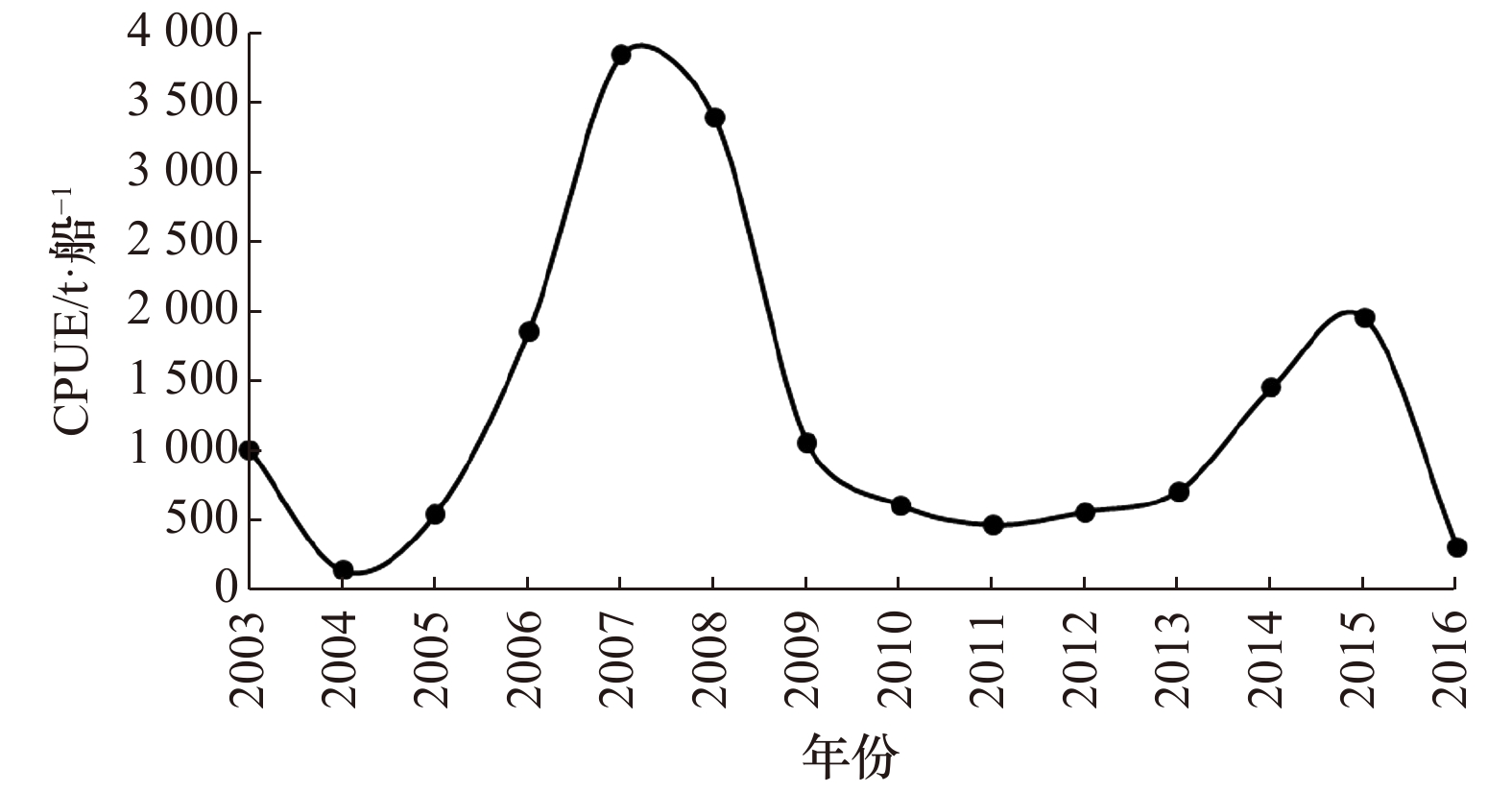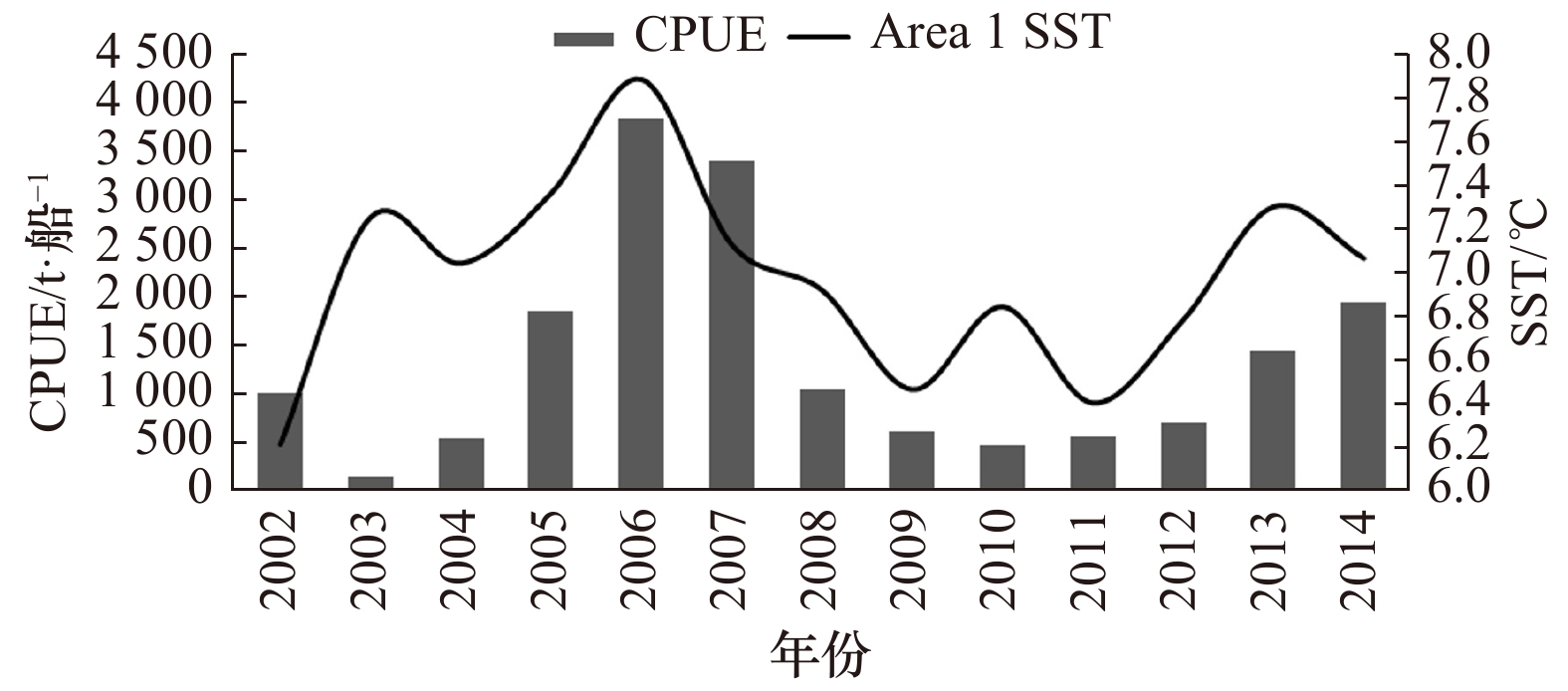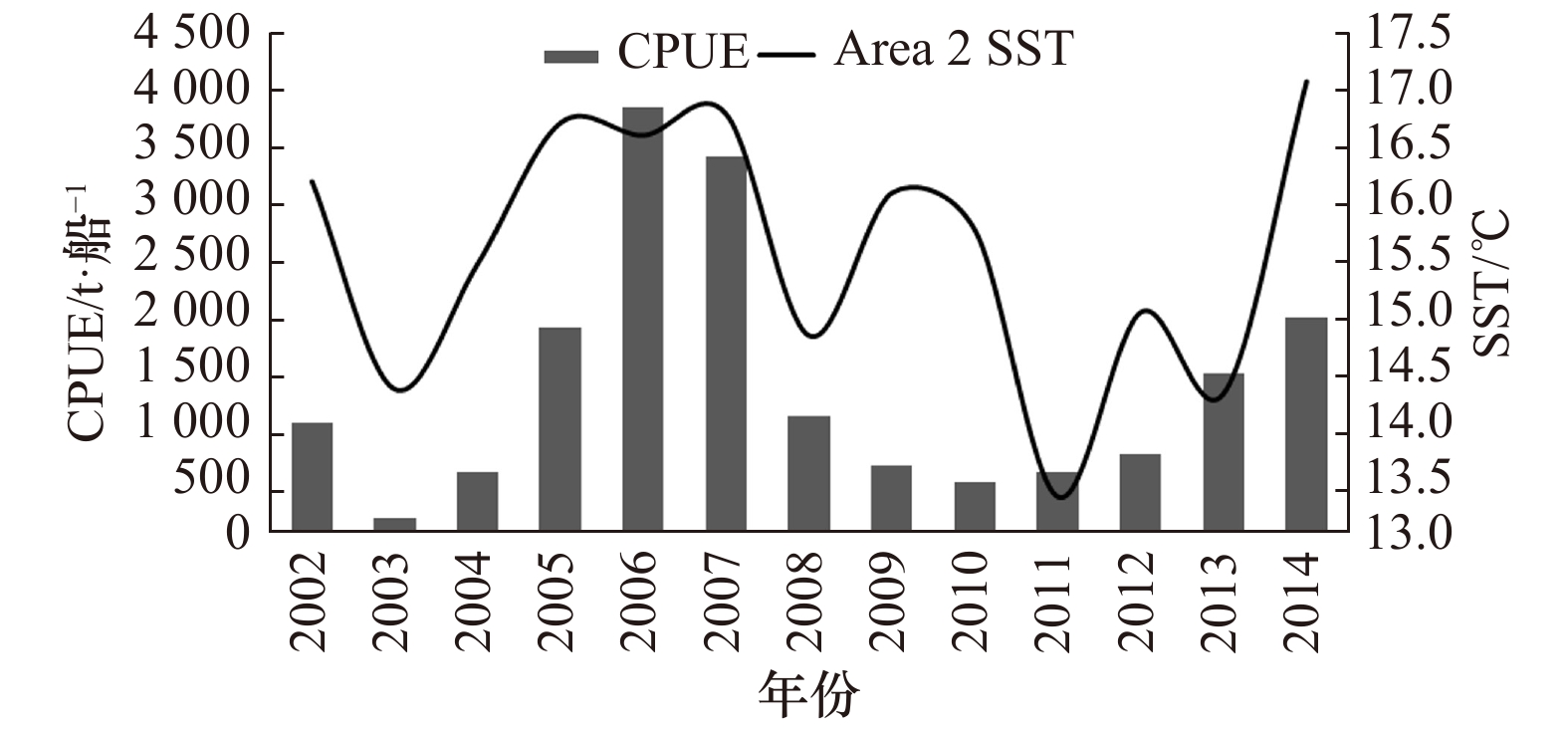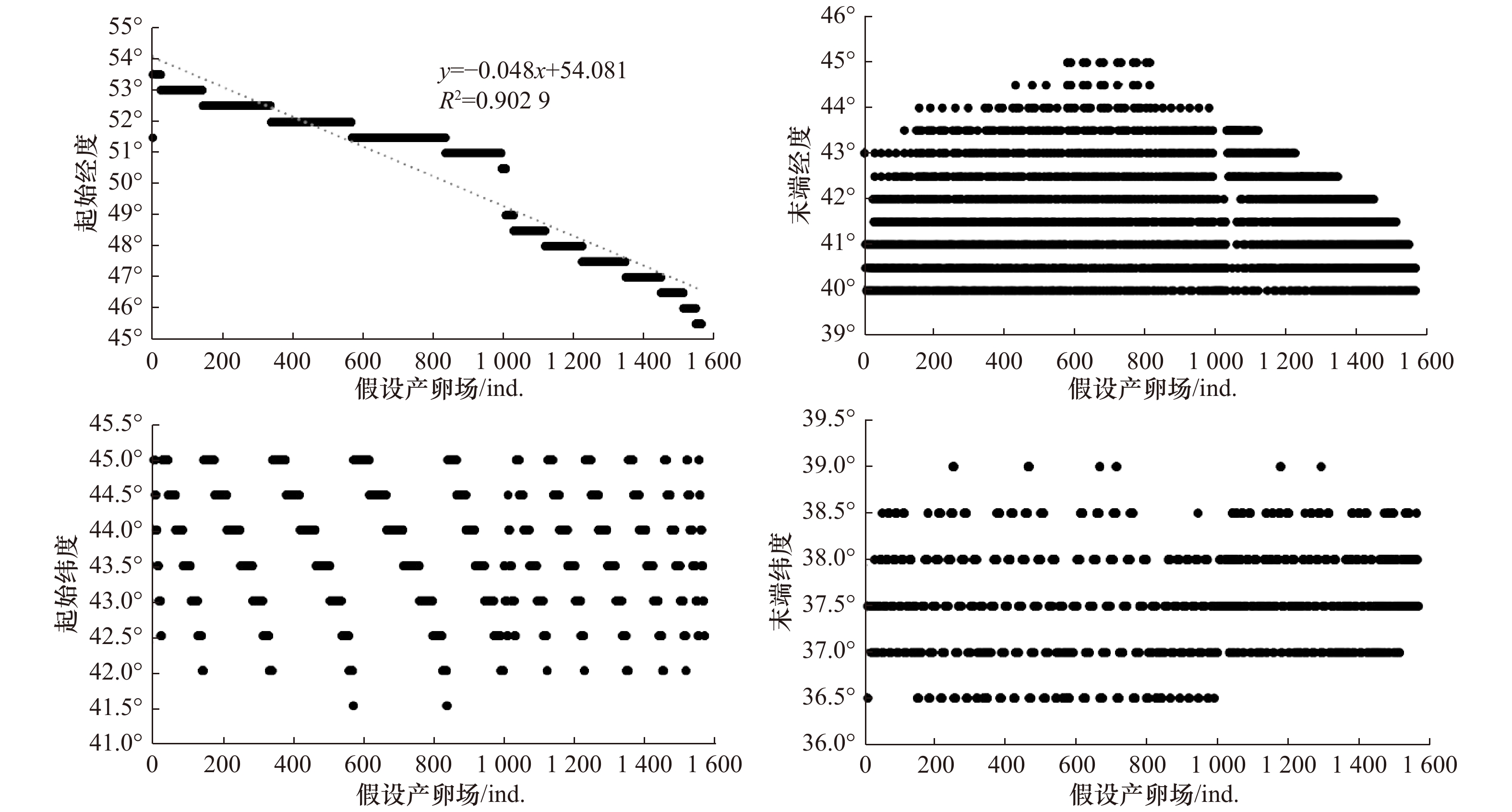Research on the abundance prediction model of Illex argentinus based on sea surface temperature of spawning ground
-
摘要: 阿根廷滑柔鱼(Illex argentinus)为短生命周期种,其资源丰度易受海洋环境变化的影响,尤其是在产卵场的早期生活史阶段。根据2003−2016年我国鱿钓船队在西南大西洋的生产统计数据,以及产卵场海洋表面温度(SST)卫星遥感数据,用相关性分析方法筛选出阿根廷滑柔鱼产卵旺季期间(6月份)表征产卵场SST变化的特征海域;基于阿根廷滑柔鱼产卵场最适SST范围占总面积之比(Ps)与资源丰度单位捕捞努力渔获量(CPUE,t/船)呈正相关性的假设,回溯阿根廷滑柔鱼最适的产卵场及水温环境条件,并据此建立多种基于表征产卵场SST环境因子的资源丰度多元线性预测模型。相关性分析结果表明:6月份有两片连续海域(Area 1、Area 2)的SST与CPUE之间存在显著相关性,分别为42.5°~44°S、57.5°~59°W(Area 1)和39°~39.5°S、45°~46°W(Area 2);回溯的阿根廷滑柔鱼产卵场范围为37.5°~44°S、41.5°~51.5°W,产卵场最适SST范围为16~17.5℃。利用2个特征海域(Area 1、Area 2)SST以及回溯的产卵场Ps建立4种的多元线性资源丰度指数(ICPUE)预测模型,结果表明,包含表征寒暖流的特征海域和回溯产卵场Ps的方案4模型优于其他3种模型,其资源丰度指数预测模型为ICPUE=1.390 4×Ps+0.261 9×SSTArea 1+0.096 2×SSTArea 2−3.248 0。Abstract: Illex argentinus was a short life cycle species. Its resource abundance is susceptible to changes in the marine environment, especially in its early life history stage. According to the production statistics of the Chinese squid jigging fleet during 2003−2016 in the Southwest Atlantic and the sea surface temperature (SST) of the spawning ground from satellite remote sensing, the correlation analysis method was used to select the featured area representing SST changes during the spawning season (June) of I. argentinus. Based on the assumption that the ratio of optimum SST range to the total area (Ps) of the spawning ground of I. argentinus is positively correlated with the abundance index (catch per fishing unit, CPUE, t/ship), the optimum spawning area and suitable sea water temperature range of I. argentinus were traced back, and a variety of multivariate linear prediction models of abundance index based on the environmental factors were established. The correlation analysis shows that there are significant correlations between SST and CPUE in two consecutive sea areas (Area 1, Area 2) in June. They are 42.5°−44°S, 57.5°−59°W (Area 1) and 39°−39.5°S, 45°−46°W (Area 2) respectively. The inferred spawning area of I. argentinus ranges from 37.5°S to 44°S and 41.5°W to 51.5°W, and the optimum SST in the spawning area is 16°C to 17.5°C. The SSTs of two featured areas (Area 1, Area 2) and Ps in the inferred spawning area are used to establish four types of multivariate linear prediction models of abundance index (ICPUE), the results show that the fourth model containing the featured areas and Ps in the inferred spawning area is superior to the other 3 models, and its prediction model of abundance index is ICPUE=1.390 4×Ps+0.261 9×SSTArea 1+0.096 2×SSTArea 2−3.248 0.
-
表 1 产卵场特征海域SST与次年CPUE相关性分析结果
Tab. 1 The result of correlation analysis parameters between SST in key area and CPUE of next year
Area 1 Area 2 经纬度范围 42.5°~44°S,57.5°~59°W 39°~39.5°S,45°~46°W R 0.618 7 0.609 2 p 0.024 2 0.027 1 表 2 推测产卵场(37.5°~44°S,41.5°~51.5°W)不同最适SST范围的Ps与CPUE相关性分析结果
Tab. 2 The result of correlation analysis parameters between Ps of different optimal SST ranges and CPUE in forecasted spawning ground (37.5°−44°S,41.5°−51.5°W)
产卵场最适SST范围 R p 15.5~17℃ 0.470 2 0.104 9 16~17.5℃ 0.654 5 0.015 2 16.5~18℃ 0.205 0 0.501 6 17~18.5℃ −0.083 2 0.787 0 15.5~17.5℃ 0.544 3 0.054 4 16~18℃ 0.524 2 0.065 9 16.5~18.5℃ 0.113 4 0.712 1 15.5~18℃ 0.502 7 0.080 0 16~18.5℃ 0.381 1 0.198 8 表 3 多元线性模型方程以及预报结果
Tab. 3 Multiple linear model equations and forecast results
方案 多元线性预测模型方程 R p MSE 1 ICPUE=2.570 1×Ps+0.253 6×SSTArea 1−1.928 2 0.732 1 0.021 5 0.037 9 2 ICPUE=2.581 6×Ps+0.092 6×SSTArea 2−1.602 0 0.720 6 0.025 7 0.039 2 3 ICPUE=0.328 0×SSTArea 1+0.124 2×SSTArea 2−3.868 5 0.774 7 0.010 2 0.032 6 4 ICPUE=1.390 4×Ps+0.261 9×SSTArea 1+0.096 2×SSTArea 2−3.248 0 0.796 2 0.023 5 0.029 9 表 4 多元线性模型方程自变量t检验结果
Tab. 4 Multivariate linear model equation variable t test result
方案 t(Ps) t(SST 1) t(SST 2) 1 1.816 2.522 2 1.956 2.375 3 2.394 2.332 4 1.910 2.678 2.552 -
[1] 王尧耕, 陈新军. 世界大洋性经济柔鱼类资源及其渔业[M]. 北京: 海洋出版社, 2005.Wang Yaogeng, Chen Xinjun. World Oceanic Economic Ommastrephidae Resources and their Fisheries[M]. Beijing: China Ocean Press, 2005. [2] Chen Xinjun, Liu Bilin, Chen Yong. A review of the development of Chinese distant-water squid jigging fisheries[J]. Fisheries Research, 2008, 89(3): 211−221. doi: 10.1016/j.fishres.2007.10.012 [3] 陆化杰, 陈新军, 刘必林, 等. 西南大西洋阿根廷滑柔鱼渔业生物学研究进展[J]. 广东海洋大学学报, 2010, 30(4): 91−98. doi: 10.3969/j.issn.1673-9159.2010.04.019Lu Huajie, Chen Xinjun, Liu Bilin, et al. Progress in fishery biology of Illex argentinus in the Southwest Atlantic Ocean[J]. Journal of Guangdong Ocean University, 2010, 30(4): 91−98. doi: 10.3969/j.issn.1673-9159.2010.04.019 [4] 余为, 陈新军, 易倩, 等. 北太平洋柔鱼早期生活史研究进展[J]. 上海海洋大学学报, 2013, 22(5): 755−762.Yu Wei, Chen Xinjun, Yi Qian, et al. Review on the early life history of neon flying squid Ommastrephes bartramii in the North Pacific[J]. Journal of Shanghai Ocean University, 2013, 22(5): 755−762. [5] Houde E D. Patterns and trends in larval-stage growth and mortality of teleost fish[J]. Journal of Fish Biology, 1997, 51(SA): 52−83. doi: 10.1111/j.1095-8649.1997.tb06093.x [6] Hatanaka H. Growth and life span of short-finned squid Illex argentinus in the waters off Argentina[J]. Nihon Suisan Gakkaishi, 1986, 52(1): 11−17. doi: 10.2331/suisan.52.11 [7] Roberts M J. The influence of the environment on chokka squid Loligo vulgaris reynaudii spawning aggregations: steps towards a quantified model[J]. South African Journal of Marine Science, 1998, 20(1): 267−284. doi: 10.2989/025776198784126223 [8] 陈新军, 刘必林, 王跃中. 2000年西南大西洋阿根廷滑柔鱼产量分布及其与表温关系的初步研究[J]. 湛江海洋大学学报, 2005, 25(1): 29−34.Chen Xinjun, Liu Bilin, Wang Yuezhong. Study on the distribution of production of Illex argentinus and its relationship with sea surface temperature in the Southwest Atlantic Ocean in 2000[J]. Journal of Zhanjiang Ocean University, 2005, 25(1): 29−34. [9] 刘必林, 陈新军. 2001年西南大西洋阿根廷滑柔鱼产量分布与表温关系的初步研究[J]. 海洋渔业, 2004, 26(4): 326−330. doi: 10.3969/j.issn.1004-2490.2004.04.016Liu Bilin, Chen Xinjun. Preliminary study on the relationship between the distribution of production of Illex argentinus and SST in the Southwest Atlantic Ocean in 2001[J]. Marine Fisheries, 2004, 26(4): 326−330. doi: 10.3969/j.issn.1004-2490.2004.04.016 [10] 张炜, 张健. 西南大西洋阿根廷滑柔鱼渔场与主要海洋环境因子关系探讨[J]. 上海海洋大学学报, 2008, 17(4): 471−475.Zhang Wei, Zhang Jian. A discussion about relationship between the distribution of production of Illex argentinus and marine environmental factors in the Southwest Atlantic Ocean[J]. Journal of Shanghai Fisheries University, 2008, 17(4): 471−475. [11] 陆化杰, 陈新军. 2006年西南大西洋鱿钓渔场与表温和海面高度距平值的关系[J]. 大连海洋大学学报, 2008, 23(3): 230−234. doi: 10.3969/j.issn.1000-9957.2008.03.015Lu Huajie, Chen Xinjun. Fishing ground of squid specially related with sea surface temperature and sea surface height anomaly in southwest Atlantic in 2006[J]. Journal of Dalian Fisheries University, 2008, 23(3): 230−234. doi: 10.3969/j.issn.1000-9957.2008.03.015 [12] 张龙, 徐汉祥, 张洪亮, 等. 2012年西南大西洋公海阿根廷滑柔鱼产量分布与表温关系研究[J]. 浙江海洋学院学报:自然科学版, 2013, 32(3): 189−193.Zhang Long, Xu Hanxiang, Zhang Hongliang, et al. Study on the distribution of production of Illex argentinus and its relationship with sea surface temperature in the Southwest Atlantic Ocean in 2012[J]. Journal of Zhejiang Ocean University: Natural Science, 2013, 32(3): 189−193. [13] Waluda C, Rodhouse P, Podestá G, et al. Surface oceanography of the inferred hatching grounds of Illex argentinus (Cephalopoda: Ommastrephidae) and influences on recruitment variability[J]. Marine Biology, 2001, 139(4): 671−679. doi: 10.1007/s002270100615 [14] 陆化杰. 西南大西洋阿根廷滑柔鱼渔业生物学及资源评估[D]. 上海: 上海海洋大学, 2012.Lu Huajie. Fisheries biology and resource assessment of Illex argentinus in the Southwest Atlantic Ocean[D]. Shanghai: Shanghai Ocean University, 2012. [15] 汪金涛, 高峰, 雷林, 等. 基于产卵场环境因子的阿根廷滑柔鱼资源补充量预报模型研究[J]. 海洋学报, 2014, 36(12): 119−124.Wang Jintao, Gao Feng, Lei Lin, et al. Study on forecasting model of recruitment for Illex argentinus by using the environmental factors in the spawning ground[J]. Haiyang Xuebao, 2014, 36(12): 119−124. [16] Brunetti N E, Ivanovic M L. Distribution and abundance of early life stages of squid (Illex argentinus) in the south-west Atlantic[J]. ICES Journal of Marine Science, 1992, 49(2): 175−183. doi: 10.1093/icesjms/49.2.175 [17] Basson M, Beddington J R, Crombie J A, et al. Assessment and management techniques for migratory annual squid stocks: the Illex argentinus, fishery in the Southwest Atlantic as an example[J]. Fisheries Research, 1996, 28(1): 3−27. doi: 10.1016/0165-7836(96)00481-X [18] Benediktsson J A, Swain P H, Ersoy O K. Neural network approaches versus statistical methods in classification of multisource remote sensing data[J]. IEEE Transactions on Geoscience and Remote Sensing, 1990, 28(4): 540−552. doi: 10.1109/TGRS.1990.572944 [19] 瓦普尼克. 统计学习理论[M]. 许建华, 张学工, 译. 北京: 电子工业出版社, 2004.Vapnik V N. Statistical Learning Theory[M]. Xu Jianhua, Zhang Xuegong, trans. Beijing: Publishing House of Electronics Industry, 2004. [20] O'Dor R K. Big squid in big currents[J]. South African Journal of Marine Science, 1992, 12(1): 225−235. doi: 10.2989/02577619209504705 [21] Brunetti N E, Elena B, Rossi G R, et al. Summer distribution, abundance and population structure of Illex argentinus on the Argentine shelf in relation to environmental features[J]. South African Journal of Marine Science, 1998, 20(1): 175−186. doi: 10.2989/025776198784126386 [22] Brunetti N E, Ivanovic M L, Louge E, et al. Reproductive biology and fecundity of two stocks of the squid (Illex argentinus)[J]. Frente Marítimo, 1991, 8(A): 73−84. -




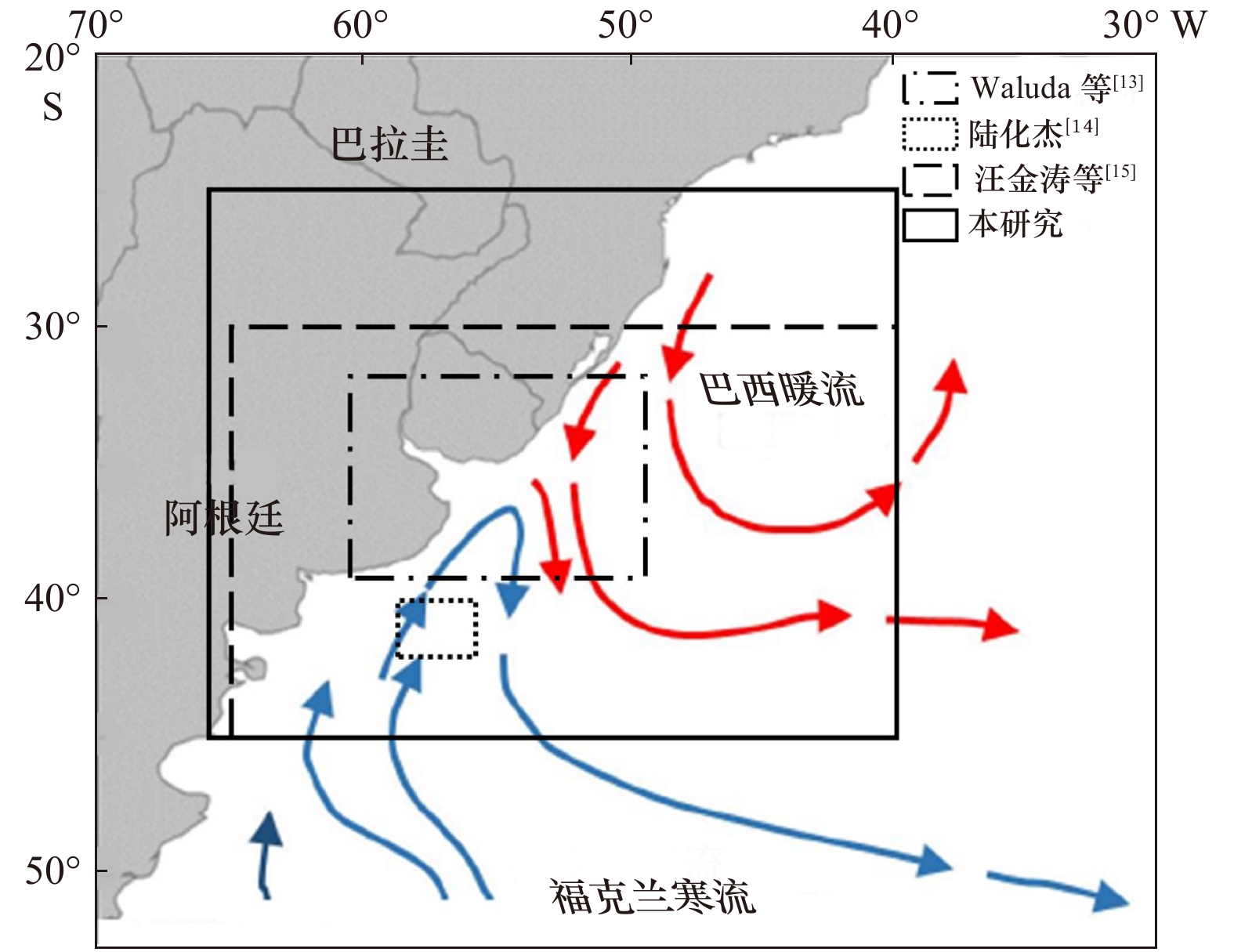
 下载:
下载:

